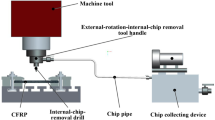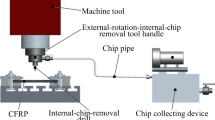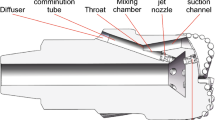Abstract
In order to automatically recover chips during the drilling process of carbon fiber reinforced polymer (CFRP), a new chip removal system of drilling processing, the suction-type internal chip removal system, has been put forward. The developed system can effectively recover chips produced in the drilling processing, which helps realize the green production. For this, at first, a method for solving the negative pressure value of the drilling of the suction-type internal chip removal system is given based on the calculation of suspension velocity of particles in gas-solid two-phase fluid mechanics. Secondly, the influence of inner-chip-removal drilling bit chip removal channel structure on the chip removal system performance is analyzed by FLUENT simulation. Finally, the correctness of the above theoretical analysis and simulation is verified through experiments, and the influence of drill speed and feed ratio on the performance of the system is further analyzed.
Similar content being viewed by others
References
Wang FJ, Yin JW, Ma JW, Jia ZY, Yang F, Niu B (2017) Effects of cutting edge radius and fiber cutting angle on the cutting-induced surface damage in machining of unidirectional CFRP composite laminates. Int J Adv Manuf Technol 91(9–12):3107–3120
QI ZC, Liu S, Cheng H, Meng QX, Li Y (2016) Research on the mesoscopic cutting mechanism of CFRP based on three-dimensional multiphase finite element models. J Mech Eng 52(15):170–176
Yin JW, Jia ZY, Wang FJ, Chen C, Zhang BY (2016) FEM simulation analysis of subsurface damage formation based on continuously cutting process of CFRP. J Mech Eng 52(17):58–64
Bonnet C, Poulachon G, Rech J, Girard Y, Costes JP (2015) CFRP drilling: fundamental study of local feed force and consequences on hole exit damage. Int J Mach Tool Manu 94:57–64
Lou B, Li Y, Zhang KF, Cheng H, Liu SN (2015) A novel prediction model for thrust force and torque in drilling interface region of CFRP/Ti stacks. Int J Adv Manuf Technol 81(9–12):1497–1508
Isbilir O, Ghassemieh E (2013) Numerical investigation of the effects of drill geometry on drilling induced delamination of carbon fiber reinforced composites. Compos Struct 105(8):126–133
Tsao CC (2008) Thrust force and delamination of core-saw drill during drilling of carbon fiber reinforced plastics (CFRP). Int J Adv Manuf Technol 37(1–2):23–28
Iliescu D, Gehin D, Gutierrez ME, Girot F (2010) Modeling and tool wear in drilling of CFRP. Int J Mach Tool Manu 50(2):204–213
Feito N, Puente JL, Santiuste C, Miguélez MH (2014) Numerical prediction of delamination in CFRP drilling. Compos Struct 108(1):677–683
Montoya M, Calamaz M, Gehin D, Girot F (2013) Evaluation of the performance of coated and uncoated carbide tools in drilling thick CFRP/aluminium alloy stacks. Int J Adv Manuf Technol 68(9–12):2111–2120
Khashaba U (2013) Drilling of polymer matrix composites: a review. J Compos Mater 47(15):1817–1832
Wang B, Gao H, Guo DM (2011) Influence of resin cure temperature and fiber layup style on the drilling quality of C/E composites. J Mech Eng 47(12):19–25
Wang XN, Hu S, Zhao J, Wang FL (2006) Flow distribution characteristics for branch pipe in pneumatic conveying. China Mech Eng 17(20):2110–2112
Xie ZL, Zhang Z (2001) Numerical simulation of pneumatic conveying. J B Univ Chem Technol (Nat Sci Ed) 28(1):22–27
Alexeenko AA, Levin DA, Gimelshein SF, Collins RJ, Markelv GN (2015) Numerical simulation of high-temperature gas flows in a millimeter-scale thruster. J Thermophys Heat Transf 16(1):10–16
Rajan KS, Srivastava SN, Pitchumani B, Mohanty B (2006) Simulation of gassolid heat transfer during pneumatic conveying: use of multiple gas inlets along the duct. Int Commun Heat Mass Transfer 33(10):1234–1242
Dzido G, Palica M, Raczek J (2002) Investigations of the acceleration region in the vertical pneumatic conveying. Powder Technol 127(2):99–106
Mason DJ, Levy A (1998) The effect of a bend on the particle ceoss section concentration and segregation in pneumatic conveying systems. Powder Technol 98(2):95–103
Yang L, Xie YH (2006) Pneumatic conveying engineering. Mechanical Industry Press
Lu ZJ, Cao WZ, Liu J, Wu RQ (1997) Research of suspension of particle in reactor. Chem Eng (China) 5(25):42–46
Funding
This work is financially supported by The National Natural Science Fund under the Project 51475127.
Author information
Authors and Affiliations
Corresponding author
Rights and permissions
About this article
Cite this article
Xu, C., Yiwen, W., Jiazhong, X. et al. Calculation of negative-pressure chip in suction-type internal chip removal system and analysis of influencing factors. Int J Adv Manuf Technol 99, 201–209 (2018). https://doi.org/10.1007/s00170-018-2443-6
Received:
Accepted:
Published:
Issue Date:
DOI: https://doi.org/10.1007/s00170-018-2443-6




